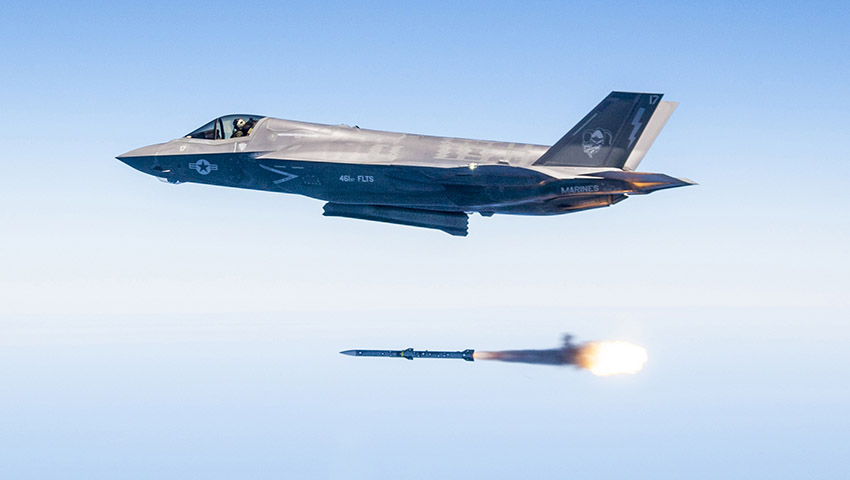Lockheed Martin has revealed a new weapon mounting rack to enable the F-35 A and C variants to carry two more missiles internally – increasing the air-to-air capability of the fifth-generation fighter.
To continue reading the rest of this article, please log in.
Create free account to get unlimited news articles and more!
For the F-35, the combination of low-observability, sensor fusion, situational awareness and strike capability will ensure that the fifth-generation fighter remains the undisputed king of the skies, well into the 2040s.
Technology is a powerful piece of the intricate jigsaw that makes up the capability of the F-35, but when it comes to achieving air superiority and prosecuting ground strikes with pinpoint accuracy, the platform's multi-role heritage and the versatility this affords provides it with a lethal combination.
The new rack, called 'Sidekick', enables each of the two weapons bays of the Air Force F-35A and US Navy carrier-capable F-35C to carry three AIM-120 Advanced Medium-Range Air-to-Air Missiles (AMRAAM) instead of the current two, for a total of six internally carried AMRAAMs.
Lockheed Martin F-35 Test Pilot Tony 'Brick' Wilson said, "The extra missiles add a little weight but are not adding extra drag."
Wilson explained that the addition of the 'Sidekick' weapons rack enhanced the F-35's internal weapons capacity, adding the F-35 can carry more AMRAAMs on external pylons, but Wilson pointed out that carrying two more internally preserves the stealth characteristics of the F-35.
The versatility of the F-35 is best defined by its two distinct, equally potent load-outs, designed for highly-specialised missions ranging from penetrating enemy air defences and gaining air superiority to deep, precision strike against well defended, integrated enemy air defence networks. These two modes are 'stealth' and 'beast' modes.
Wilson explained that 'Sidekick' rack had been designed and developed entirely by Lockheed Martin using internal research and development funds – the introduction of this capability will increase the air-to-air missile capacity by 50 per cent.
Australia's F-35s will make use of the Raytheon-designed AIM-120C AMRAAM missile – which is currently the only air-to-air missile cleared to fly on the F-35. The AMRAAM provides the F-35 with a leading-edge air-dominance weapon.
The AMRAAM's advanced active guidance section provides aircrew with a high degree of combat flexibility and lethality. Its mature seeker design allows it to quickly find targets in the most combat challenging environments.
The aircraft's AIM-120 AMRAAM missiles in themselves are developed for flexibility in operations, being used for air-to-air and surface launch engagements. The missiles have a range over 20 miles, and incorporates active radar with an inertial reference unit and micro-computer system, allowing the missile to depend less on the fire-control system of the aircraft.
The Lockheed Martin F-35 Joint Strike Fighter is billed as a catalyst for the fifth-generation revolution, changing the face and capability of the Royal Australian Air Force and the wider Australian Defence Force.
For the RAAF, the F-35A's combination of full-spectrum low-observable stealth coatings and materials, advanced radar-dispersing shaping, network-centric sensor and communications suites – combined with a lethal strike capability – means the aircraft will be the ultimate force multiplying, air-combat platform.
Over the coming years, Australia will purchase 72 of the advanced fifth-generation fighter aircraft as part of the $17 billion AIR 6000 Phase 2A/B program – which is aimed at replacing the ageing F/A-18A/B Classic Hornets that have been in service with the RAAF since 1985.
Stephen Kuper
Steve has an extensive career across government, defence industry and advocacy, having previously worked for cabinet ministers at both Federal and State levels.

 Login
Login








